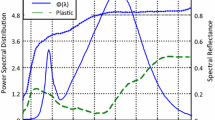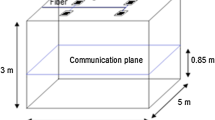Abstract
In this paper, the performance of an indoor visible light communication (VLC) system in the presence of Gaussian-plus-Laplacian additive noise is investigated. Initially, a realistic VLC system model is established by considering the effects of channel gain and Gaussian-plus-Laplacian additive noise. Theoretical expressions of the average bit error rate (ABER) and average channel capacity are derived, respectively. To show the system performance at a high signal-to-noise ratio, the asymptotic ABER expression is obtained. Numerical results show that all theoretical results agree well with the simulation results. Moreover, the effects of Laplacian noise scale parameter, dimming target, Lambertian order, and the radius of the receiver zone on system performance are also discussed.









Similar content being viewed by others
Notes
If the receiver is fixed in the receiver zone, the channel is determined, and the system performance can be characterized by using instantaneous BER and instantaneous channel capacity.
In addition to random receiver location, random receiver orientation in VLC can also result in the random channel gain, which will be investigated in the future.
In the VLC system, the optical interference noise, such as fluorescent noise, incandescent noise, and direct current noise, can be filtered out with a special filter [33]. As a result, the optical interference noise is ignored.
References
Chamani, S., Rostami, A., & Mirtaheri, P. (2022). A superimposed QD-based optical antenna for VLC: White LED source. Nanomaterials, 12(15), 1–15. https://doi.org/10.3390/nano12152573
Arfaoui, M. A., Ghrayeb, A., Assi, C., & Qaraqe, M. (2022). CoMP-Assisted NOMA and cooperative NOMA in indoor VLC cellular systems. IEEE Transactions on Communications, 70(9), 6020–6034. https://doi.org/10.1109/TCOMM.2022.3190887
Arfaoui, M. A., Soltani, M. D., Tavakkolnia, I., Ghrayeb, A., Assi, C., Haas, H., & Safari, M. (2019). SNR statistics of indoor mobile VLC users with random device orientation. IEEE International Conference on Communications Workshops, 2019, 1–6. https://doi.org/10.1109/ICCW.2019.8756957
Arfaoui, M. A., Soltani, M. D., Tavakkolnia, I., Ghrayeb, A., Safari, M., Assi, C. M., & Haas, H. (2020). Physical layer security for visible light communication systems: A survey. IEEE Communications Surveys & Tutorials, 22(3), 1887–1908. https://doi.org/10.1109/COMST.2020.2988615
Sharda, P., Reddy, G. S., Bhatnagar, M. R., & Ghassemlooy, Z. (2022). A comprehensive modeling of vehicle-to-vehicle based VLC system under practical considerations, an investigation of performance, and diversity property. IEEE Transactions on Communications, 70(5), 3320–3332. https://doi.org/10.1109/TCOMM.2022.3158325
Sadat, H., Abaza, M., Mansour, A., & Alfalou, A. (2022). A survey of NOMA for VLC systems: Research challenges and future trends. Sensors, 22(4), 1–23. https://doi.org/10.3390/s22041395
Céspedes, M. M., Guzmán, B. G., & Jiménez, G. V. P. (2021). Lights and shadows: A comprehensive survey on cooperative and precoding schemes to overcome LOS Blockage and interference in indoor VLC. Sensors, 21(3), 1–41. https://doi.org/10.3390/s21030861
Li, B., Xu, W., Feng, S., & Li, Z. (2019). Spectral-efficient reconstructed LACO-OFDM transmission for dimming compatible visible light communications. IEEE Photonics Journal, 11(1), 1–14. https://doi.org/10.1109/JPHOT.2019.2892849
Ahn, K., & Kwon, J. K. (2012). Capacity analysis of M-PAM inverse source coding in visible light communications. Journal of Lightwave Technology, 30(10), 1399–1404. https://doi.org/10.1109/JLT.2012.2185780
Wang, J.-Y., Fu, X.-T., Lu, R.-R., Wang, J.-B., Lin, M., & Cheng, J. (2021). Tight capacity bounds for indoor visible light communications with signal-dependent noise. IEEE Transactions on Wireless Communications, 20(3), 1700–1713. https://doi.org/10.1109/TWC.2020.3035615
Sekhar, K. R., & Mitra, R. (2020). MBER combining for MIMO VLC with user mobility and imperfect CSI. IEEE Communications Letters, 24(2), 376–380. https://doi.org/10.1109/LCOMM.2019.2954496
Kumar, A., & Ghorai, S. K. (2018). BER performance analysis of indoor MIMO-VLC system for multipath reflection. Technologies for Smart-City Energy Security and Power, 2018, 1–5. https://doi.org/10.1109/ICSESP.2018.8376688
Hameed, S. M., Abdulsatar, S. M., & Sabri, A. A. (2021). BER comparison and enhancement of different optical OFDM for VLC. International Journal of Intelligent Engineering and Systems, 14(4), 326–336.
Wang, J.-B., Hu, Q.-S., Wang, J., Chen, M., & Wang, J.-Y. (2013). Tight bounds on channel capacity for dimmable visible light communications. Journal of Lightwave Technology, 31(23), 3771–3779. https://doi.org/10.1109/JLT.2013.2286088
Jiang, R., Wang, Z., Wang, Q., & Dai, L. (2016). A tight upper bound on channel capacity for visible light communications. IEEE Communications Letters, 20(1), 1089–7798. https://doi.org/10.1109/LCOMM.2015.2497694
Farid, A. A., & Hranilovic, S. (2010). Capacity bounds for wireless optical intensity channels with Gaussian noise. IEEE Transactions on Information Theory, 56(12), 6066–6077. https://doi.org/10.1109/TIT.2010.2080470
Landa, I., Vélez, M., & Arrinda, A. (2018). Impulsive noise measurements from consumer electronic devices. IEEE Conference on Antenna Measurements & Applications, 2018, 1–4. https://doi.org/10.1109/CAMA.2018.8530479
Blackard, K. L., Rappaport, T. S., & Bostian, C. W. (1993). Measurements and models of radio frequency impulsive noise for indoor wireless communications. IEEE Journal on Selected Areas in Communications, 11(7), 991–1001. https://doi.org/10.1109/49.233212
Wu, I., Ohta, H., Gotoh, K., Ishigami, S., & Matsumoto, Y. (2014). Characteristics of radiation noise from an LED lamp and its effect on the BER performance of an OFDM system for DTTB. IEEE Transactions on Electromagnetic Compatibility, 56(1), 132–142. https://doi.org/10.1109/TEMC.2013.2277596
Majumder, A., & Caffery, J. J. (2004). Power line communications. IEEE Potentials, 23(4), 4–8. https://doi.org/10.1109/MP.2004.1343222
Pillay, N., & Xu, H. (2021). Error performance analysis of access point-based reconfigurable intelligent surfaces in the presence of Gaussian-plus-Laplacian additive noise. IEEE Access, 9, 158287–158296. https://doi.org/10.1109/ACCESS.2021.3131127
Ma, Y. H., So, P. L., & Gunawan, E. (2005). Performance analysis of OFDM systems for broadband power line communications under impulsive noise and multipath effects. IEEE Transactions on Power Delivery, 20(2), 674–682. https://doi.org/10.1109/TPWRD.2005.844320
Selim, B., Alam, M. S., Kaddoum, G., & Agba, B. L. (2020). Effect of impulsive noise on uplink NOMA systems. IEEE Transactions on Vehicular Technology, 69(3), 3454–3458. https://doi.org/10.1109/TVT.2020.2964275
Marks, R. J., Wise, G. L., Haldeman, D. G., & Whited, J. L. (1978). Detection in Laplace noise. IEEE Transactions on Aerospace and Electronic Systems, 14(6), 866–872. https://doi.org/10.1109/TAES.1978.308550
Bartoli, G., Beaulieu, N. C., Fantacci, R., & Marabissi, D. (2014). Optimal data rate for reliable packet communications in Laplace noise. IEEE Communications Letters, 18(1), 2–5. https://doi.org/10.1109/LCOMM.2013.111213.130944
Wang, J.-Y., Qiu, Y., Lin, S.-H., Wang, J.-B., Lin, M., & Liu, C. (2020). On the secrecy performance of random VLC networks with imperfect CSI and protected zone. IEEE Systems Journal, 14(3), 4176–4187. https://doi.org/10.1109/JSYST.2019.2947614
Huang, C. & Zhang, X. (2017). LOS-NLOS identification algorithm for indoor visible light positioning system. 2017 20th International Symposium on Wireless Personal Multimedia Communications, 575-578. https://doi.org/10.1109/WPMC.2017.8301878
Komine, T., & Nakagawa, M. (2004). Fundamental analysis for visible-light communication system using LED lights. IEEE Transactions on Consumer Electronics, 50(1), 100–107. https://doi.org/10.1109/TCE.2004.1277847
Jani, M., Garg, P., & Gupta, A. (2020). Performance analysis of a mixed cooperative PLC-VLC system for indoor communication systems. IEEE Systems Journal, 14(1), 469–476. https://doi.org/10.1109/JSYST.2019.2911717
Pan, G., Ye, J., & Ding, Z. (2017). On secure VLC systems with spatially random terminals. IEEE Communications Letters, 21(3), 492–495. https://doi.org/10.1109/LCOMM.2016.2643632
Cho, S., Chen, G., & Coon, J. P. (2018). Physical layer security in visible light communication systems with randomly located colluding eavesdroppers. IEEE Wireless Communications Letters, 7(5), 768–771. https://doi.org/10.1109/LWC.2018.2820709
Fu, X.-T., Lu, R.-R., & Wang, J.-Y. (2021). Realistic performance analysis for visible light communication with random receivers. Journal of the Optical Society of America. A, 38(5), 654–662. https://doi.org/10.1364/JOSAA.412972
Adiono, T., & Fuada, S. (2017). Optical interference noise filtering over visible light communication system utilizing analog high-pass filter circuit. International Symposium on Nonlinear Theory and Its Applications, 2017, 616–619.
Prakash, S., Bansal, A., & Jha, S. K. (2016) Performance analysis of narrowband PLC system under Gaussian Laplacian noise model. 2016 International Conference on Electrical, Electronics, and Optimization Techniques, 3597-3600. https://doi.org/10.1109/ICEEOT.2016.7755376
Lapidoth, A., Moser, S. M., & Wigger, M. A. (2009). On the capacity of free-space optical intensity channels. IEEE Transactions on Information Theory, 55(10), 4449–4461. https://doi.org/10.1109/TIT.2009.2027522
Cover, T. M., & Thomas, J. A. (2006). Elements of Information Theory (2nd ed.). Wiley.
Gradshteyn, I. S. & Ryzhik, I. M. Table of Integrals, Series, and Products, 7th ed. Academic Press.
Prudnikov, A. P., Bryčhkov, Y. A., & Maričhev, O. I. Integrals and Series: Special Functions, vol. 2. Gordon & Breach Science Publishers.
Fath, T., & Haas, H. (2013). Performance comparison of MIMO techniques for optical wireless communications in indoor environments. IEEE Transactions on Communications,61(2), 733–742. https://doi.org/10.1109/TCOMM.2012.120512.110578
Nuwanpriya, A., Ho, S.-W., & Chen, C. S. (2015). Indoor MIMO visible light communications: Novel angle diversity receivers for mobile users. IEEE Journal on Selected Areas in Communications, 33(9), 1780–1792. https://doi.org/10.1109/JSAC.2015.2432514
Jiang, R., Wang, Q., Wang, F., Dai, L., & Wang, Z. (2015). An optimal scaling scheme for DCO-OFDM based visible light communications. Optics Communications, 356(2015), 136–140. https://doi.org/10.1016/j.optcom.2015.07.053
Adamchik, V. S., & Marichev, O. I. (1990). The algorithm for calculating integrals of hypergeometric type functions and its realization in REDUCE system. Proceedings of the International Symposium on Symbolic and Algebraic Computation,pp. 212–224. https://doi.org/10.1145/96877.96930
Acknowledgements
This work was supported by Natural Science Foundation of Jiangsu Province under Grant BK20221328, the Opening Project of Guangdong Provincial Key Laboratory of Aerospace Communication and Networking Technology, and the open research fund of Henan Key Laboratory of Visible Light Communications under Grant HKLVLC2023-B02.
Author information
Authors and Affiliations
Contributions
Na Liu had the idea for the article and wrote the main manuscript text. Li-Hua Hong, Pan Feng, and Hao-Nan Yang prepared the figures and tables. Professor Jin-Yuan Wang is the instructor of this paper. All authors reviewed the manuscript.
Corresponding author
Ethics declarations
Conflict of interest
All authors certify that they have no affiliations with or involvement in any organization or entity with any financial interest or non-financial interest in the subject matter or materials discussed in this manuscript.
Additional information
Publisher's Note
Springer Nature remains neutral with regard to jurisdictional claims in published maps and institutional affiliations.
Appendices
Appendix A: Proof of Theorem 1
The first part \({{f}_{1}}\) is given by
Using the upper incomplete Gamma function, eq. (19) holds.
The second part \({{f}_{2}}\) is given by
Let the integrand function be
By using the composite Simpson’s rule, \({{f}_{2}}\) is excepressed as
Therefore, eq. (20) holds.
The third part \({{f}_{3}}\) is given by
Because the solution process of \({{f}_{3}}\) is similar to \({{f}_{2}}\), Eq. (21) can be obtained.
The fourth part \({{f}_{4}}\) is given by
Utilizing [38, Eq. (1.5.1.3)], Eq. (22) holds.
Appendix B: Proof of Lemma 1
When \(\lambda \rightarrow 0\), the combined PDF can be expressed as
According to the definition of the Gaussian Q-function, \(Q(-\frac{n}{\sigma }+\frac{\sigma }{\lambda })\) is given by
By using the L’Hospital rule for \({{L}_{1}}\) in (B.1), we have
Similarly, \({{L}_{2}}\) is written as
Therefore, the combined PDF can be expressed as
Appendix C: Proof of Corollary 2
For a M-QAM DCO-OFDM based VLC system, the instantaneous BER is given by [41]
where SNDR is the received signal-to-noise-plus-distortion ratio, and it is given by
According to (17), the average BER in this scenario is expressed as (C.3), shown at the bottom of this page. By applying the composite Simpson’s rule to \({{f}_{5}}\) and \({{f}_{6}}\), eq. (27) can be obtained.
Appendix D: Proof of Theorem 2
For indoor VLC, the ACC can be expressed as
For the first term \({{y}_{1}}\), we have
Let \({{h}^{2}}=t\), \({{y}_{2}}\) in (D.1) can be simplified as
By using (11) and (26) in [42], the following equality holds
By using (D.4), \({{I}_{1}}\) can be written as (D.5), shown at the bottom of this page.
Therefore, \({{y}_{2}}\) can be finally given by
where \(\mu (a,b,c,d)\) is defined by (36).
Rights and permissions
Springer Nature or its licensor (e.g. a society or other partner) holds exclusive rights to this article under a publishing agreement with the author(s) or other rightsholder(s); author self-archiving of the accepted manuscript version of this article is solely governed by the terms of such publishing agreement and applicable law.
About this article
Cite this article
Liu, N., Hong, LH., Feng, P. et al. Performance analysis for visible light communications with Gaussian-plus-Laplacian additive noise. Telecommun Syst 85, 373–387 (2024). https://doi.org/10.1007/s11235-023-01081-7
Accepted:
Published:
Issue Date:
DOI: https://doi.org/10.1007/s11235-023-01081-7




